Animal Traps
Table of Contents
Although you can technically for weeks without food, you're going to start feeling weak after just a few days. And in a survival situation, you want to make sure you have enough energy to not just stay alive, but to actively improve your changes of rescue. Foraging for food can work in some areas, but it can also be very time consuming. If you have the skills and materials, setting up traps can yield more food for less work.
Note that the following has been heavily sourced from an article originally published by Field and Stream.
3 Tips for Building Animal Traps
You can significantly improve the chances your trap will work if you plan accordingly. Animals follow patterns and understanding these patterns can go a long way to helping you acquire a meal.
1. Location: Rabbits, muskrats, groundhogs, and other animals usually follow the same trails through meadows and forests. These trails make for ideal locations for traps. In bright sunlight such trails can be difficult to spot so make use of the shadows of early mornings and late afternoons as a guide.
2. Direction: Sometimes it is possible to improve the “funneling effect” of a trail by narrowing it with small sticks and brush stuck in the ground. Doing so will force animals to pass through your trap. In addition, horizontal sticks placed at just the right height can “trick” animals in to ducking right in to the snare you've set up.
3. Size: A good rule to follow is to make your trap's noose about 1.5 times the diameter of the head of the animal you wish to trap. Also, use materials that are strong enough for your intended prey, but weak enough to so that larger game won't be accidentally injured.
When it comes to making traps, the most important construction material is a spool of snare wire. According to Field and Stream, 26 gauge is about right for all-purpose small-game snares; 28 gauge for squirrels; and 24 or heavier for beaver-size animals. In addition, “soft, single-strand wire is superior to nylon monofilament because it holds its shape and game can't chew through it.” In a pinch, snares can also be made from braided fishing superlines or 550 parachute cord.
Squirrel Snare
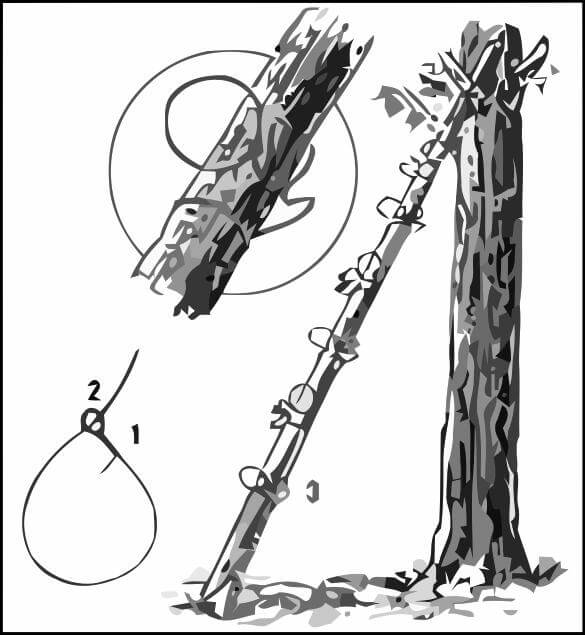
- Make a small loop by wrapping the snare wire around a pencil-diameter stick twice, then turning the stick to twist the wire strands together.
- Pass the long wire end through the loop to form the snare.
- To build a squirrel snare, attach a series of small wire snares around a long stick propped against a tree. You can catch several at a time with this setup.
Twitch-Up Snare Trap
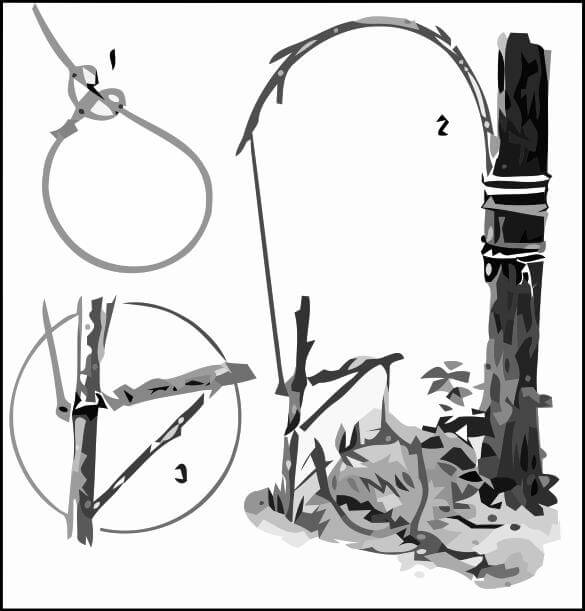
- Tie a small overhand loop knot in your parachute cord, then fold the loop back on itself to form Mickey Mouse ears and weave the tag end through the ears as illustrated.
- To build the twitch-up snare, use more cord to tie a spring pole or the branch of a small tree in tension.
- Set up a trigger mechanism like the one shown. When the animal's head goes through the loop, the trigger is released, and it snatches the animal into the air, out of reach of other predators.
Ojibway Bird Trap
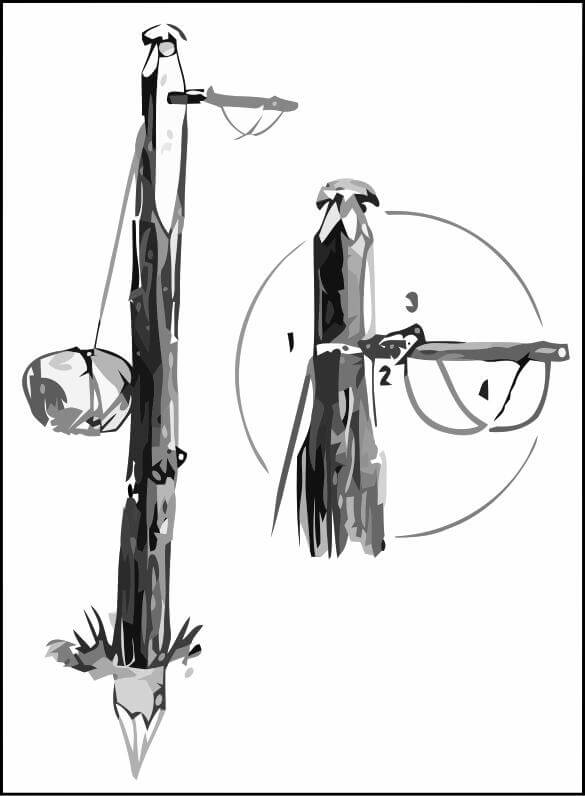
This works best when set in a clearing where the trigger stick offers a handy perch. The slightest weight on the trigger should cause it to fall and the noose to catch the bird by its feet.
- Cut a 1/4-inch-diameter hole through one end of a stout 3-foot-long pole with a knife. If necessary, shave the sides of the pole to make it thin enough to make the hole. Sharpen the bottom end of the pole and drive it into the ground.
- Whittle the end of the trigger stick so that it resembles a pencil with the point cut off. This end should fit loosely inside the hole in the pole.
- Insert thin cord or fishing line through the hole and tie an overhand knot. Beyond the knot, form a noose. Tie the other end of the cord to a rock.
- Drape the noose over both sides of the trigger and insert it into the pole (if it's breezy, wet the cord with saliva to help it stay put). Draw the cord until the knot catches at the point where the trigger fits into the hole, to keep it from falling back through–until a bird alights on the small stick.
Two-Stick Deadfall Trap
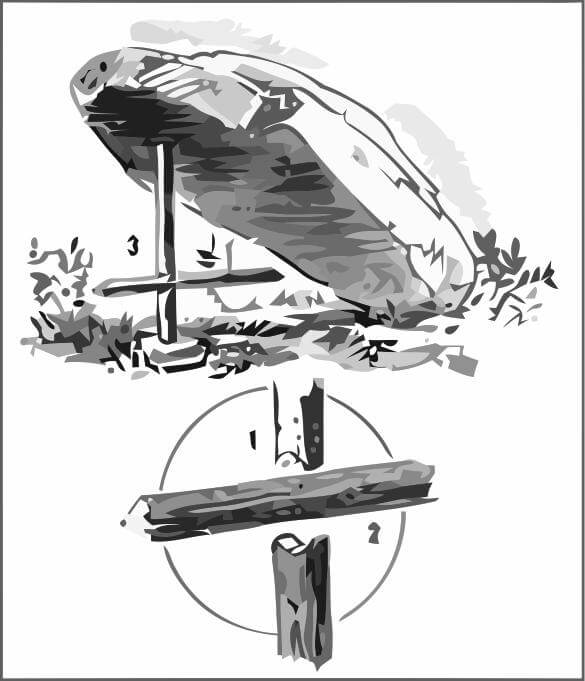
Your intention here is to create a precarious balance, so the slightest jostling of the trigger will cause the trap to collapse.
- Cut a shallow groove in one end of both upright sticks.
- Insert the trigger stick between the grooves. The upright sticks should not meet at the center of the trigger.
- Balance the sticks as shown under the weight of the deadfall.
Fish Trap
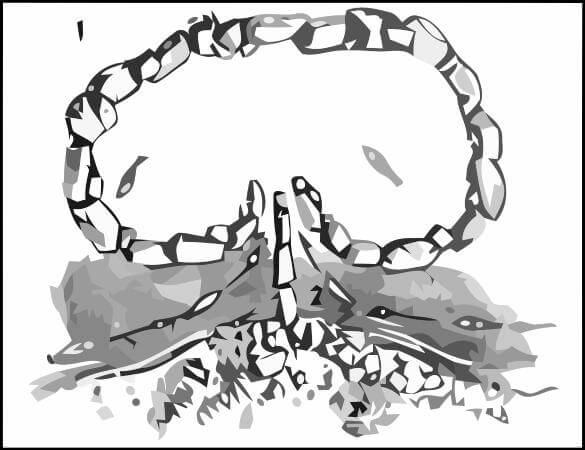
After dark, fish often cruise the shorelines of a lake or the shallow inside bend of a stream's ideal places for a trap.
- Build it as shown with the materials at hand: logs, rocks, or stakes driven into the bottom.
- The diversion arm of the trap directs fish into the V entrance. Most won't be able to find their way out. Close the entrance and net the fish with a seine made by tying a shirt between two poles. This is much more effective than trying to spear fish or catch them with your hands.



have any of you fellers ever live in the bush for a extended period of time?.it dosent sound like it to me.
i love trapping animals I use every trap there is and I am always successful.
Well ... i don't love fishing but i trapped a lot of squirrels with sq. snare and deadfalls !
Best traps are : simple snare, deadfalls , twitch-up snare ( with platform) and cage traps ( some models) ..the other traps are bullshists....almost( a very good trap is the gin trap)! ;)
i always wanted to make a trap but i aint had time to do it. does any1 kmow what the easiest and time efficent trap is
I built a twitch up snare on a 4 way animal trail and baited it with peanut butter. I managed to catch the neighbours dog instead of small game. Im going to build a bigger version and use a 50 pound boulder as a weight and sling it over a high tree branch and attach it to the trap instead of using a sapling. should be able to catch me some diner
Though it is extremely unlikely that anyone would ever end up 'stranded', given the population density, the point is not to 'be prepared' with any particular material thing, rather, to be prepared mentally. A minimal knowledge of basic mechanics, biology, botany, and other life sciences will allow one to make some sort of trap or another. I'm certain there is a corollary to Murpheys law that states that no matter what physical stuff you're prepared with, it will not be the right stuff for a serious situation. There should probably also be a corollary that states your chances of survival have something to do with your knowledge base, and how cool you keep our head.
Snares can be woven from smashed fibrous plants. Sticks are easy to sharp, pits can be dug, rocks are everywhere. Pick stuff up, feel it, asess it's properties, i.e. stiffness, tensile strength, hardness, etc. It's all in your head.
Shoelaces? Boot laces? Those will work. Besides, you should always plan for emergencies and have some basic survival items with you. That's the point of being prepared. Reading this page alone will not help you. You have to go out and practice the skills.
i don't see how your going to find snare wire in the middle of a wood? and it's not the kind of thing i keep in my pocket all the time!
> i don't see how your going to find snare wire in the middle of a wood?
Well, rosi, this question seems pretty basic. There many, many ways to make cordage suitable for a snare but the most obvious for someone who is stranded is to tear off a narrow strip of cloth from some article of clothing you're carrying and twist it. Even better by using a little wax from a candle. Rub it on, warm the cloth until the wax melts and then let it cool and it will stiffen. Or else pine pitch will also do this but rub it in the dirt so it's not sticky after. If you twist waxed cloth tight before it cools, it will become a fairly stiff, round piece of cordage. Another method would be to make a narrow lace from any skin such as even road kill or any remains you stumble across. Even the inner bark from some woody bush or tree will often work. Scrape the hair off any skin material you're using, cut it into narrow thongs and if it's too thin because the animal is small, then make the thong a little wider and twist it into a round piece of lacing and dry it. It doesn't need to be wire but the critter should choke to death quickly or it might chew its way free and this is true with wire too.
-Paw, Doomer in Chief
http://groups.yahoo.com/group/brierpatch/
Well I think that if you are planning a trip into the woods then carrying some extra items with you would be a sensible move anyway.
ok yall i understand about how yall dont get were to ind that crap and if your so freakin useless that you cant if anything find a rock and stick in the wild i dont see how you dont choke too death on rice
i like these traps they are cool but i dont understand the bird one if the rock is holding it up how does the bird fall into the snare
the rock is attached to the snare not the stick idiot
make sure u look up how to skin and eat the animal before you kill it... my friend killed a squirrel with my bb gun and then we where like wth do we do now? we ended up goin back to my house and eating lucky charms =]
You trying to tell me you REALLY can't find a tree and a stick in the wilderness... Really?
good ideas but if you ahve actualy tried them in the woods with minimal matirial you would know these are very hard to pull of
Tis is the stupidest thing i have ever seen in my life.....if you are lost in the wilderness......where do you plan on finding all this crap?
So the survival techniques from seasoned experts and the US Army are the stupidest things you have ever seen. Of course you're not going to find snare wire or parachute cords in the wild. It assumes you have made some elementary preparations and have brought these materials with you. And of course you should be able to find a few branches, sticks and rocks in the wilderness.
Then again if it's that stupid to you just ignore them and die.
i like the two-stick deathfall trap the best,because it crushes the animal.
i like all the traps im goning into the woods tommorrow an ill set some up an let the rest know what works
What are the best things to look for in spotting a large animal dead fall pit to avoid falling into one?
how do attatch the nooses to the stick in the squirrel snare?
Just tie them to the log, I'm going to try and see if I can make most of them and see if I'm successful. :)
the twitch up snare trap is the best
i like the twtch-up snare trap
Thanks DE. If you know of any other animal trap resources, let me know. I'd like to bring together a more complete list.
Excellent tips on how to catch game to eat and help you when you're lost.